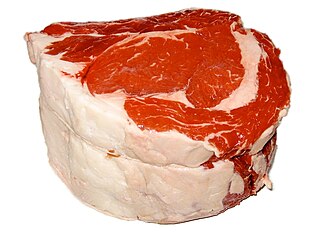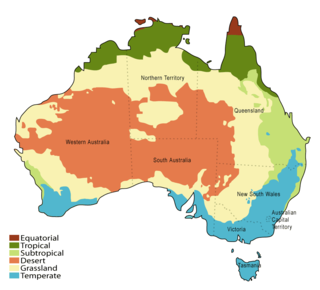Related Research Articles

Beef is the culinary name for meat from cattle. Beef can be prepared in various ways; cuts are often used for steak, which can be cooked to varying degrees of doneness, while trimmings are often ground or minced, as found in most hamburgers. Beef contains protein, iron, and vitamin B12. Along with other kinds of red meat, high consumption is associated with an increased risk of colorectal cancer and coronary heart disease, especially when processed. Beef has a high environmental impact, being a primary driver of deforestation with the highest greenhouse gas emissions of any agricultural product.

A hamburger, or simply burger, is a food consisting of fillings—usually a patty of ground meat, typically beef—placed inside a sliced bun or bread roll. Hamburgers are often served with cheese, lettuce, tomato, onion, pickles, bacon, or chilis; condiments such as ketchup, mustard, mayonnaise, relish, or a "special sauce", often a variation of Thousand Island dressing; and are frequently placed on sesame seed buns. A hamburger patty topped with cheese is called a cheeseburger.

Australian cuisine is the food and cooking practices of Australia and its inhabitants. Australia has absorbed culinary contributions and adaptations from various cultures around the world, including British, European, Asian and Middle Eastern.

Quorn is a brand of meat substitute products, or the company that makes them. Quorn originated in the UK and is sold primarily in Europe, but is available in 14 countries. The brand is owned by parent company Monde Nissin.

A meat alternative or meat substitute, is a food product made from vegetarian or vegan ingredients, eaten as a replacement for meat. Meat alternatives typically approximate qualities of specific types of meat, such as mouthfeel, flavor, appearance, or chemical characteristics. Plant- and fungus-based substitutes are frequently made with soy, but may also be made from wheat gluten as in seitan, pea protein as in the Beyond Burger, or mycoprotein as in Quorn.

A veggie burger is a hamburger made with a patty that does not contain meat, or the patty of such a hamburger. The patty may be made from ingredients like beans, nuts, grains, seeds, or fungi such as mushrooms or mycoprotein.

Horse meat forms a significant part of the culinary traditions of many countries, particularly in Eurasia. The eight countries that consume the most horse meat consume about 4.3 million horses a year. For the majority of humanity's early existence, wild horses were hunted as a source of protein.

Although Australia is mostly arid, the nation is a major agricultural producer and exporter, with over 325,300 employed in agriculture, forestry and fishing as of February 2015. Agriculture and its closely related sectors earn $155 billion-a-year for a 12% share of GDP. Farmers and grazers own 135,997 farms, covering 61% of Australia's landmass. Across the country there is a mix of irrigation and dry-land farming. The success of Australia to become a major agricultural power despite the odds is facilitated by its policies of long-term visions and promotion of agricultural reforms that greatly increased the country's agricultural industry.

Ramly Processing Sdn. Bhd. is a Malaysian frozen and fast food company founded by Ramly bin Mokni through Pemasaran Ramly Mokni Sdn. Bhd.

Bush tucker, also called bush food, is any food native to Australia and historically eaten by Indigenous Australians, the Aboriginal and Torres Strait Islander peoples, but it can also describe any native flora, fauna, or funga used for culinary or medicinal purposes, regardless of the continent or culture. Animal native foods include kangaroo, emu, witchetty grubs and crocodile, and plant foods include fruits such as quandong, kutjera, spices such as lemon myrtle and vegetables such as warrigal greens and various native yams.

Kangaroo meat is produced in Australia from wild kangaroos and is exported to over 60 overseas markets.
Beef Products Inc. (BPI) is an American meat processing company based in Dakota Dunes, South Dakota. Prior to high media visibility of its products, it was a major supplier to fast food chains, groceries and school lunch programs. It had three additional plants, which closed in 2012.

Pink slime is a meat by-product used as a food additive to ground beef and beef-based processed meats, as a filler, or to reduce the overall fat content of ground beef. As part of the production process, heat and centrifuges remove the fat from the meat in beef trimmings. The resulting paste, without the fat, is exposed to ammonia gas or citric acid to kill bacteria. In 2001, the United States Department of Agriculture (USDA) approved the product for limited human consumption. The product, when prepared using ammonia gas, is banned for human consumption in the European Union and Canada.

A steak is a thick cut of meat generally sliced across the muscle fibers, sometimes including a bone. It is normally grilled or fried. Steak can be diced, cooked in sauce, such as in steak and kidney pie, or minced and formed into patties, such as hamburgers.

The 2013 horse meat scandal was a food industry scandal in parts of Europe in which foods advertised as containing beef were found to contain undeclared or improperly declared horse meat – as much as 100% of the meat content in some cases. A smaller number of products also contained other undeclared meats, such as pork. The issue came to light on 15 January 2013, when it was reported that horse DNA had been discovered in frozen beefburgers and lasagna sold in several Irish and British supermarkets.
Laurence "Larry" Goodman is an Irish businessman, chiefly involved in the beef processing industry. He is the 6th generation of a livestock and meat exporting family and founded what is now ABP Food Group in 1954. He is the Executive Chairman of the company which has grown to become one of Europe’s largest agri-business companies with 51 processing plants in Ireland, the United Kingdom, Spain, France, Denmark, Holland, Austria, Poland. ABP employs over 11,000 people. Separately, the Goodman family office has business interests in property, healthcare and productive arable and beef farming.

Grill'd is an Australian-owned multinational casual dining restaurant chain specialising in healthy burgers. Founded by Simon Crowe in 2004 in Hawthorn, Melbourne, the group now has over 150 restaurants.
Halal literally means "permissible" in Arabic and refers to food items that are permissible to consume under Sharia law, whereas haram refers to any substance not permitted to consume. According to the Australian Food and Grocery Council, halal foods must be "free from any substance taken or extracted from a haram animal or ingredient ; [be] made, processed, manufactured and/or stored by using utensils, equipment and/or machinery that has been cleaned according to Islamic law ; and [be] free from contact with, or being close to, a haram substance during preparation, manufacture, processing and storage ."
Impossible Foods Inc. is a company that develops plant-based substitutes for meat products. The company's signature product, the Impossible Burger, was launched in July 2016 as a vegan alternative to beef hamburger.

The Operation Carne Fraca is an operation started on March 17, 2017, and enforced by the Federal Police of Brazil, that country's federal police force, which investigated some of the country's largest meat processing companies. The name is a pun between the operation's concern with meat and the Bible verse about "weak flesh" – as a result, it is sometimes translated "Operation Weak Flesh".
References
- 1 2 3 "AUSTRALIAN MEAT WILL BE INSPECTED". The New York Times. 26 August 1981 – via NYTimes.com.
- 1 2 3 Kretowicz, Ewa (18 November 2012). "How they fed us donkey burgers". The Canberra Times.
- 1 2 3 4 5 6 7 Branigin, William (4 October 1981). "Let Them Eat 'Roo". The Washington Post. ISSN 0190-8286 . Retrieved 26 February 2023.
- 1 2 3 4 "Australians are hopping mad over kangaroo-for-beef scandal". The Christian Science Monitor. ISSN 0882-7729 . Retrieved 26 February 2023.
- ↑ Kretowicz, Ewa (17 November 2012). "'Skippy meat' scandal became global joke". The Canberra Times.
- 1 2 Spriggs, John; Isaac, Grant (2001). Food Safety and International Competitiveness: The Case of Beef. CABI. p. 109. ISBN 978-0-85199-858-9.
- 1 2 Curll, Janine (1 January 2015). "The significance of food fraud in Australia". Australian Business Law Review.
- ↑ Australian Meat Industry - Royal Commission - Report, dated September 1982
- 1 2 3 4 Grabosky P & Sutton A 1989. Stains on a white collar: fourteen studies in corporate crime or corporate harm. Canberra: Australian Institute of Criminology.
- ↑ Croly, Herbert David (1981). The New Republic. Republic Publishing Company. pp. 8–10.
- ↑ "An Australian meat company owner said Wednesday he replaced... - UPI Archives". UPI. Retrieved 26 February 2023.
- ↑ Fitzgerald, Ross (1984). From 1915 to the Early 1980s: A History of Queensland. University of Queensland Press. p. 416. ISBN 978-0-7022-1734-0.
- ↑ Hooker, Neal H.; Murano, Elsa A. (8 March 2001). Interdisciplinary Food Safety Research. CRC Press. p. 57. ISBN 978-1-4200-3909-2.